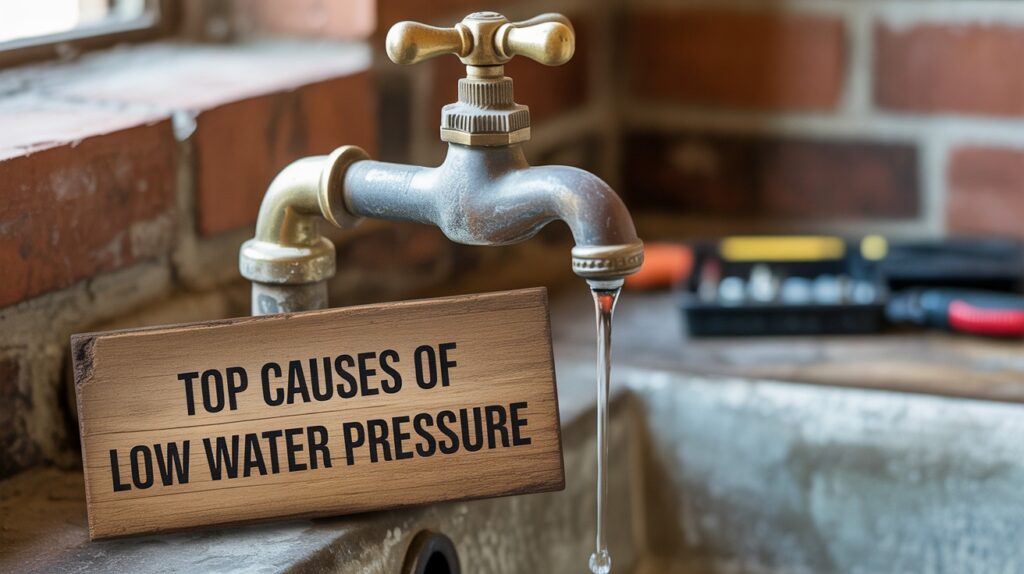Nothing can ruin a nice shower or a productive dish-washing moment quicker than low water pressure. Low water pressure can be a nuisance, disrupt your day-to-day life, cause damage to your appliances, and indicate that there may be a larger problem with your plumbing system. The good news? Most causes are fairly easy to identify, and some causes are easy to repair.
Here’s a rundown of some of the most common causes of low water pressure in your home, along with some things you can do about it.
Common Causes of Low Water Pressure and Their Fixes
Low water pressure can make daily tasks feel like annoying chores. Whether it is a slow shower or a feeble kitchen faucet, it can be frustrating with fluctuating water pressure. The following is a list of the most likely causes and their easy fixes. Let’s have a detailed look at them.
Clogged Aerators or Showerheads
Mineral buildup, sediment, and even minute debris can accumulate in faucet aerators and showerheads over time. This restricts water flow and leads to a water trickle rather than a steady stream.
How to fix it
- Remove the showerhead or aerator.
- Soak it in vinegar for a few hours to break down mineral deposits.
- Rinse well and install it in its place again.
This temporary fix will usually be enough to re-establish full pressure, particularly if the issue is limited to a single fixture.
Leaky Pipes
Even a small leak can affect water pressure. If there is water leaking somewhere in your plumbing system, there is less of it that makes it to your fixtures.
Signs of a leak:
- Water marks on walls or ceilings
- Moldy smell on walls or under sinks
- Unexpected rise in your water bill
How to fix it
Find the leak and either patch it temporarily or hire a professional to fix or replace the damaged part. If ignored, leaks can cause structural damage as well as mold growth.
Faulty Pressure Regulator
A water pressure regulator keeps water coming into your home at a safe, consistent rate. When it goes bad, you will experience an unexpected loss (or gain) of pressure in the house.
How to fix it
- Test the pressure on a gauge on an outside spigot.
- If levels are too low (less than 40 psi) or inconsistent, replace the regulator.
Note: This is usually a job for a professional plumber since regulators are directly attached to the main water supply line.
Corroded Plumbing
If you live in an older house with a plumbing system that has pipes made of galvanized steel, you may have corrosion buildup inside the pipes, and as a result, it will block the flow of water.
How to fix it
Unfortunately, the only permanent solution is to replace the corroded pipes with newer materials like copper or PEX. It may be a larger investment, but it enhances pressure and reliability.
Water Supply Issues
Sometimes, the issue is not in your house or your fixtures. Sometimes, the municipal maintenance work, heavy usage, or faulty municipal infrastructure can affect the water pressure and the water supply to your house from time to time.
How to fix it
- Inquire with neighbors whether they are suffering from the same issue or not.
- Get a quick update from your local water supplier.
If it is on the supply side, you might just have to wait for the utility company to repair it.
Malfunctioning Plumbing Parts
If your water pressure problem is only associated with a fixture in specific areas, like a bathroom shower or kitchen faucet, it is more likely that the issue is the individual parts of that specific fixture (i.e., shower faucet parts or faucet cartridge).
Water can only flow at a specific angle and volume through worn-out parts, such as blocking debris or being stuck in between the points of operation. The water either dribbles out or comes out sporadically instead of flowing continuously through the fixture for use.
How to fix it
- Look for obvious mineral buildup and clean it out.
- If cleaning does not work, replacing the part is typically simple and easy.
A simple plumbing part can make a big difference in the functioning of a fixture.
Preventive Measures for Future High Water Pressure Issues
After water pressure returns to normal, a few things can be done to maintain it.
- Regular Cleaning – Make it a habit to take out and clean aerators and showerheads once every few months.
- Annual Inspections – Let a plumbing expert inspect your system (they will find corrosion, leaks, pressure problems, etc., before they become serious).
- Water Softener – A water softener is a good way to minimize mineral buildup if you live in a hard-water area.
- Replace Old Parts – If your fixtures or valves are old and start to fail, don’t wait for them to completely fail. Replace it before a failure occurs.
Bottom Line
Low water pressure is not uncommon, but it is rarely without a fix. Whether it is a quick cleaning of a clogged aerator, a simple replacement of a defective part, or even a new installation of old pipes, there is always a solution.
Mostly, the fix is obvious and easily helps in getting a steady, consistent water flow. By addressing the problem early on and taking preventive measures, you can keep your showers feeling like a cool splash, your appliances running at top speed, and your home in top condition.

